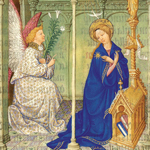 |
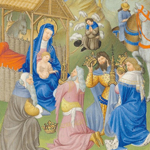 |
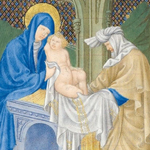 |
Above: Details of illuminations from Folio 30r, Folio 54v, and Folio 57r from the Belles Heures of Jean de France, duc de Berry, 1405–1408/9. Herman, Paul, and Jean de Limbourg (Franco-Netherlandish, active in France by 1399–1416). French; Made in Paris. Ink, tempera, and gold leaf on vellum; 9 3/8 x 6 5/8 in. (23.8 x 16.8 cm). The Metropolitan Museum of Art, New York, The Cloisters Collection, 1954 (54.1.1).
The essential text of any book of hours is the Hours of the Virgin, also known as the Little Office of the Blessed Virgin Mary. It is a devotional work composed of a set of psalms interspersed with lessons, prayers, and brief phrases of praise and petition. It was first written in the ninth century for the use of the clergy, but adapted over time for the laity, and was extremely popular from the mid-thirteenth through sixteenth centuries. By the end of the period, printed books rather than manuscripts dominated. The “hours” refer to the eight canonical hours of the day: Matins, Lauds, Prime, Terce, Sext, None, Vespers, and Compline. These hours were based in the ancient Roman systems for time, and were the hours of prayer in the Divine Office, chanted in monasteries and by the clergy, beginning with Matins and Lauds, which were sung before dawn. Books of hours were also used to teach children to read; the word “primer” comes from “Prime,” the first daytime hour.
Detail of text from Folio 30r
Each of the eight hours begins with a series of short lines, called versicles and responses. Matins begins Domine labia mea aperies et os meum annunciabit laudem tuam Deus in adjutorium meum intende (Lord, open my lips and my mouth shall tell forth thy praise. God, come to my assistance.) This is followed by a series of hymns, psalms, prayers, and canticles, and the different types of texts are noted in red (rubrics) on the text pages of the manuscript. Those first short lines, which can be seen at the bottom of the Annunciation page (see detail of Folio 30r above) of the manuscript, encapsulate the two main themes of all the hours: praise for God and requests for intercession and aid.
Illumination from Folio 30r
In the simplest books of hours, each hour might only be marked with an enlarged initial, but in luxury hours like the Belles Heures, each hour begins with an illumination, a picture from the infancy cycle of Christ. The scenes chosen are standard: the Annunciation (Folio 30r, see above) for Matins, the Visitation (Folio 42v) for Lauds, the Nativity (Folio 48v) for Prime, the Annunciation to the Shepherds (Folio 52r) for Terce, the Adoration of the Magi (Folio 54v) for Sext, the Presentation in the Temple (Folio 57r) for Nones. There is some variation among illuminated books of hours for Vespers, and in the Belles Heures the most violent scene is chosen, the Massacre of the Innocents (Folio 59v). The Flight into Egypt (Folio 63r) then concludes the cycle in Compline. All these scenes would have been familiar to the medieval reader through repeated representation in churches, whether on the altarpiece of a parish church or carved in stone in a cathedral. As I mentioned in the “Calendar Pages” post, the book of hours puts the same imagery used in the cathedral into the hands of its owner. The purpose of these traditional pictures is not to illustrate the accompanying text, but rather to provide a parallel visual narrative of the Virgin’s life to assist in meditation while reading or reciting the words that glorify her in prayer. The prayers praise God and the Virgin; the pictures provide the user with themes to contemplate and pictures to aid private reflection.
The illuminations also play a more mundane role: they act as book markers to help the reader find a particular section. The Belles Heures, like other manuscripts, had no page numbers or table of contents. The foliation that can be seen faintly in the upper right corner of the recto pages (see example) was added well after the medieval period.
Details of the borders from Folio 166r and Folio 171r
The borders of the illuminated pages in the Hours of the Virgin tell a special story. Throughout the pages of the Belles Heures, the most common border is a thin gold band around the picture or text area, which is in turn surrounded by rinceaux (scrolling bryony or ivy leaves). This type of border is on all the text pages as well as most of the illuminated pages, including Folio 166r, shown above. To mark the beginning of each traditional section of the manuscript, the thin gold line is replaced by a broader band or ribbon of painted foliage, interlace, garlands, or other patterns. These broader ribbons give greater prominence to mark the opening of the section, or, in the case of the Suffrages (see detail of Folio 171r, above), to highlight a particular saint.
Detail of border from Folio 57r
The most unusual of the rinceaux-and-band boundaries is at the hour of Nones (the Presentation in the Temple, Folio 57r); it incorporates a text, written in impossibly tiny letters, taken from one of the Penitential Psalms on a blue banderole that scrolls around the picture.
Detail of the border from Folio 30r
The special status of the Hours of the Virgin is made manifest in the Belles Heures by being the only section of the manuscript to have every one of its illuminations marked by a special border. In this section, one of these broad boundaries marks each of the hours and its illumination, and an even grander frame marks the first hour, Matins (The Annunciation, Folio 30r). The unique border created for Matins has no ivy but is painted with richly twining leafy scrolls inhabited with bears, swans, prophets, and musical angels, with tiny putti climbing the foliage, and shields identifying it all as belonging to Jean de Berry. This unique border demonstrates how the Limbourg brothers used a hierarchy of ornament to mark the Hours of the Virgin as the most important section of the book, and to aid the reader in finding each of its parts quickly.
The great popularity of the Hours of the Virgin and the book of hours as a type during the Middle Ages is due in part to the growth of the Cult of the Virgin. (See the Heilbrunn Timeline of Art History for more on this subject.) The Virgin was seen as more approachable than God or Christ, and worship of her grew with the expectation that she would be an ideal advocate on behalf of the faithful. The text of the Hours of the Virgin repeatedly praises her and asks for her intercession.
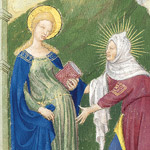 |
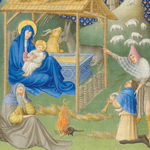 |
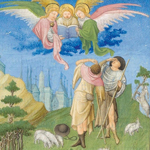 |
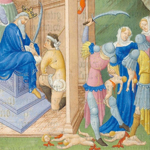 |
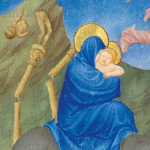 |
Details of illuminations from Folio 42v, Folio 48v, Folio 52r, Folio 59v, and Folio 63r
The previously discussed Annunciation (Folio 30r) focuses on the humility of the Virgin, expressed in her downward glance and crossed hands. In the Visitation (Folio 42v), she dominates the figure of her cousin, yet still hangs back in modesty. In the Nativity (Folio 48v), all the figures hug the perimeter of the composition. The Annunciation to the Shepherds (Folio 52r) dramatizes the stunned reaction to the angels’ message, with one shepherd gazing so far up and back that he is about to topple on his crossed legs. The Massacre of the Innocents (Folio 59v) is horrifying in its explicit bloody violence, in strong contrasted to the tenderness of the Flight into Egypt (Folio 63r).
The Hours of the Virgin, as the essential text of a book of hours, was of course planned to be part of the Belles Heures from the beginning. Like all the traditional sections of the manuscript, its pages were laid out for two columns of text written in black ink. On the pages with illuminations, that text is reduced to four lines, but they are still in two columns and in black ink. This is not one of the special added “picture book” sections of the Belles Heures but it is the heart of the manuscript nevertheless.
—Wendy A. Stein
Tags: Hours of the Virgin

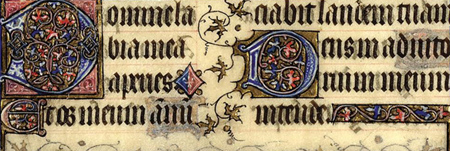
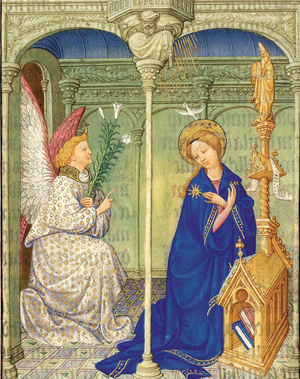
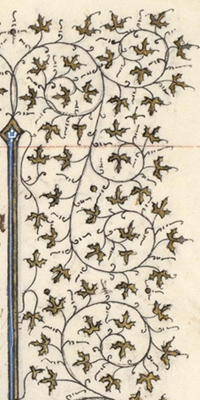
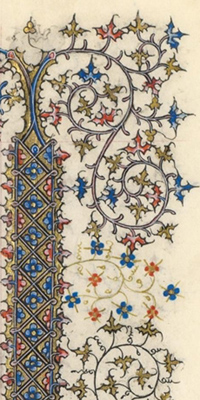


March 29, 2010 at 2:12 PM
Greetings, Wendy—
I enjoyed this discussion of the Hours of the Virgin, especially the special attention given to the individual borders of the illuminations for the canonical hours and the ‘hierarchy of ornament’ in the Belles Heures. Do you know W. H. Auden’s beautiful poetic sequence Horae Canonicae? The text is available at http://spintongues.msk.ru/auden9eng.htm
Deirdre
March 29, 2010 at 2:34 PM
Oh, Deirdre, you astonish me again with your capacity to take in the modern with the medieval and reveal the depths of human response that link and lurk and fill our understanding with new depth and new gifts.
thanks, kiddo.
w
May 3, 2010 at 12:24 AM
Una obra magnifica , que deslumbra a todos los que no pueden dejar de mirarla, porque atrapa con sus formas y colores, gloriosa la iluminacion y perfeccion en las formas.